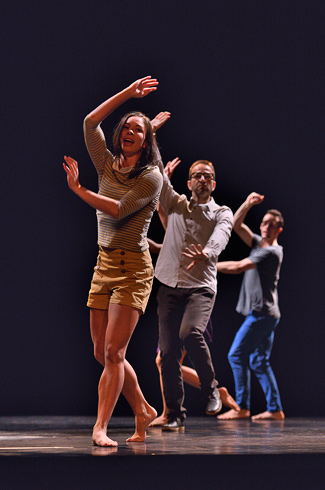Interplay
Interplay is a collection of three modern dance works by contemporary choreographers. The first, 2 in D minor, choreographer (and SDC director) Rafael Bonachela set to excerpts from J.S. Bach’s Partita 2 in D minor, to which dancers interacted with accomplished violinist Veronique Serret playing the piece live on stage. The work features a sometimes overlapping series of dance interactions each involving generally two, three, or four dancers in bewilderingly complex sinuous, circling, floating moves that, though some must have required great strength, appeared utterly effortless.
The second, Raw Models, Jacopo Godani choreographed in conjunction with the composition, by 48nord, of electroacoustic music verging sometimes on the industrial and at other times on distant science-fiction settings, very much matching the cold, blue, at times harsh, lighting and those impressions that the dance itself conveys: at various times, and depending upon your perspective, insectile life; humanoid but bizarrely alien creatures capable of articulating their limbs in strange ways; and robotic machinery capable of moving in ways foreign to ordinary human experience, with phenomenal illusions of distortion of the human body into non-mammalian articulations.
 The final work, L’Chaim! (To life!), is the choreography of Gideon Obarzanek, and composer Stefan Gregory evidently wrote the music—which began as a nothing more than a series of tones, again fairly impersonal, and ended in a warm chorus that matched the choreographer’s intent of conveying inclusiveness—mostly in response to the work’s developing choreography. This final piece makes strong use too of a live voiceover, written by David Woods, in which an observer of the work questions the dancers individually as they dance and directs our attention to whether the dance necessarily divides performers from audience members or may include us.
The final work, L’Chaim! (To life!), is the choreography of Gideon Obarzanek, and composer Stefan Gregory evidently wrote the music—which began as a nothing more than a series of tones, again fairly impersonal, and ended in a warm chorus that matched the choreographer’s intent of conveying inclusiveness—mostly in response to the work’s developing choreography. This final piece makes strong use too of a live voiceover, written by David Woods, in which an observer of the work questions the dancers individually as they dance and directs our attention to whether the dance necessarily divides performers from audience members or may include us.
The true originality of these pieces is evident not only in the passion with which the dancers perform them but also in what these performers manage to convey through them. It’s self-evidently true that not every new dance work is original or worth the effort of watching. Such is not the case here. These works deserve close attention. 2 in D minor’s marvellous flights of the body and its capture of an extraordinary range of possibilities in the interactions of three bodies was an eye-opener. Raw Models’ fascinating demonstration of at least the appearance of movements and postures so bizarre that we hadn’t imagined them possible was nevertheless precise, graceful, and beautifully coordinated throughout. L’Chaim! offers, aside from a few surprises that I won’t spoil, apparent spontaneity, and, above all, infectious joy. If I had to name a single performer for special mention, that performer would have to be Charmene Yap. I’m unable quite to put my finger on why her movements were very often captivating; I simply couldn’t look away.
Even for a modern-dance plebeian such as I am, these works were at all times interesting, often surprising, and sometimes delightful. If you enjoy creative dance, you’ll leave this trilogy with a new sense of what is possible.
Reviewer and Photographer: John P. Harvey.
Subscribe to our E-Newsletter, buy our latest print edition or find a Performing Arts book at Book Nook.

